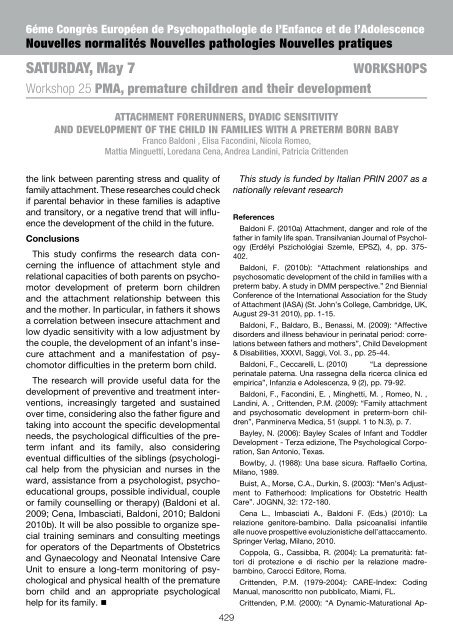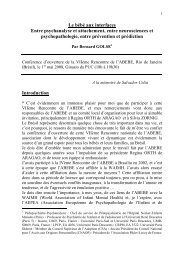Nouvelles normalités Nouvelles pathologies Nouvelles ... - Psynem
Nouvelles normalités Nouvelles pathologies Nouvelles ... - Psynem
Nouvelles normalités Nouvelles pathologies Nouvelles ... - Psynem
Create successful ePaper yourself
Turn your PDF publications into a flip-book with our unique Google optimized e-Paper software.
6° 6éme Congresso Congrès Européen Europeo de di Psicopatologia Psychopathologie dell’Infanzia de l’Enfance e et dell’Adolescenza<br />
de l’Adolescence<br />
Nuove <strong>Nouvelles</strong> normalità <strong>normalités</strong> Nuove <strong>Nouvelles</strong> patologie <strong>pathologies</strong> Nuove pratiche <strong>Nouvelles</strong> pratiques<br />
SATURDAY, May 7 WORKSHOPS<br />
Workshop 25 PMA, premature children and their development<br />
ATTACHMENT FORERUNNERS, DYADIC SENSITIVITY<br />
AND DEVELOPMENT OF THE CHILD IN FAMILIES WITH A PRETERM BORN BABY<br />
Franco Baldoni , Elisa Facondini, Nicola Romeo,<br />
Mattia Minguetti, Loredana Cena, Andrea Landini, Patricia Crittenden<br />
the link between parenting stress and quality of<br />
family attachment. These researches could check<br />
if parental behavior in these families is adaptive<br />
and transitory, or a negative trend that will influence<br />
the development of the child in the future.<br />
Conclusions<br />
This study confirms the research data concerning<br />
the influence of attachment style and<br />
relational capacities of both parents on psychomotor<br />
development of preterm born children<br />
and the attachment relationship between this<br />
and the mother. In particular, in fathers it shows<br />
a correlation between insecure attachment and<br />
low dyadic sensitivity with a low adjustment by<br />
the couple, the development of an infant’s insecure<br />
attachment and a manifestation of psychomotor<br />
difficulties in the preterm born child.<br />
The research will provide useful data for the<br />
development of preventive and treatment interventions,<br />
increasingly targeted and sustained<br />
over time, considering also the father figure and<br />
taking into account the specific developmental<br />
needs, the psychological difficulties of the preterm<br />
infant and its family, also considering<br />
eventual difficulties of the siblings (psychological<br />
help from the physician and nurses in the<br />
ward, assistance from a psychologist, psychoeducational<br />
groups, possible individual, couple<br />
or family counselling or therapy) (Baldoni et al.<br />
2009; Cena, Imbasciati, Baldoni, 2010; Baldoni<br />
2010b). It will be also possible to organize special<br />
training seminars and consulting meetings<br />
for operators of the Departments of Obstetrics<br />
and Gynaecology and Neonatal Intensive Care<br />
Unit to ensure a long-term monitoring of psychological<br />
and physical health of the premature<br />
born child and an appropriate psychological<br />
help for its family. <br />
429<br />
This study is funded by Italian PRIN 2007 as a<br />
nationally relevant research<br />
References<br />
Baldoni F. (2010a) Attachment, danger and role of the<br />
father in family life span. Transilvanian Journal of Psychology<br />
(Erdélyi Pszichológiai Szemle, EPSZ), 4, pp. 375-<br />
402.<br />
Baldoni, F. (2010b): “Attachment relationships and<br />
psychosomatic development of the child in families with a<br />
preterm baby. A study in DMM perspective.” 2nd Biennial<br />
Conference of the International Association for the Study<br />
of Attachment (IASA) (St. John’s College, Cambridge, UK,<br />
August 29-31 2010), pp. 1-15.<br />
Baldoni, F., Baldaro, B., Benassi, M. (2009): “Affective<br />
disorders and illness behaviour in perinatal period: correlations<br />
between fathers and mothers”, Child Development<br />
& Disabilities, XXXVI, Saggi, Vol. 3., pp. 25-44.<br />
Baldoni, F., Ceccarelli, L. (2010) “La depressione<br />
perinatale paterna. Una rassegna della ricerca clinica ed<br />
empirica”, Infanzia e Adolescenza, 9 (2), pp. 79-92.<br />
Baldoni, F., Facondini, E. , Minghetti, M. , Romeo, N. ,<br />
Landini, A. , Crittenden, P.M. (2009): “Family attachment<br />
and psychosomatic development in preterm-born children”,<br />
Panminerva Medica, 51 (suppl. 1 to N.3), p. 7.<br />
Bayley, N. (2006): Bayley Scales of Infant and Toddler<br />
Development - Terza edizione, The Psychological Corporation,<br />
San Antonio, Texas.<br />
Bowlby, J. (1988): Una base sicura. Raffaello Cortina,<br />
Milano, 1989.<br />
Buist, A., Morse, C.A., Durkin, S. (2003): “Men’s Adjustment<br />
to Fatherhood: Implications for Obstetric Health<br />
Care”. JOGNN, 32: 172-180.<br />
Cena L., Imbasciati A., Baldoni F. (Eds.) (2010): La<br />
relazione genitore-bambino. Dalla psicoanalisi infantile<br />
alle nuove prospettive evoluzionistiche dell’attaccamento.<br />
Springer Verlag, Milano, 2010.<br />
Coppola, G., Cassibba, R. (2004): La prematurità: fattori<br />
di protezione e di rischio per la relazione madrebambino,<br />
Carocci Editore, Roma.<br />
Crittenden, P.M. (1979-2004): CARE-Index: Coding<br />
Manual, manoscritto non pubblicato, Miami, FL.<br />
Crittenden, P.M. (2000): “A Dynamic-Maturational Ap-



